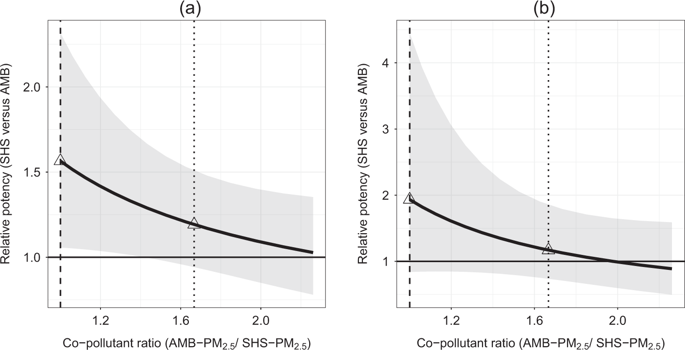当前位置:
X-MOL 学术
›
J. Expo. Sci. Environ. Epid.
›
论文详情
Our official English website, www.x-mol.net, welcomes your
feedback! (Note: you will need to create a separate account there.)
Health effects of concurrent ambient and tobacco smoke-derived particle exposures at low concentrations in children with asthma.
Journal of Exposure Science and Environmental Epidemiology ( IF 4.1 ) Pub Date : 2020-02-18 , DOI: 10.1038/s41370-020-0201-y Matthew Strand 1 , Nathan Rabinovitch 2
Journal of Exposure Science and Environmental Epidemiology ( IF 4.1 ) Pub Date : 2020-02-18 , DOI: 10.1038/s41370-020-0201-y Matthew Strand 1 , Nathan Rabinovitch 2
Affiliation

|
Exposure to particulate matter less than 2.5 microns from either ambient pollution (AMB-PM2.5) or secondhand smoke (SHS-PM2.5) have been associated with asthma worsening, but there is little information on effects and relative potency with concurrent exposures. We studied health effects of concurrent exposures to AMB-PM2.5 and SHS-PM2.5 over a 6-year period in schoolchildren with asthma. Regression calibration with instrumental variables (RCIV) was utilized to estimate effects of personal exposure to low-level SHS and AMB-PM2.5 on daily albuterol usage and urinary leukotriene E4 (uLTE4; a biomarker of asthma-related inflammation) using urine cotinine and concentrations from fixed and personal pollution monitors. Each IQR increase in SHS-PM2.5 exposure was associated with a 6.7% increase (95% CI: 1.0-12.8%) in uLTE4 on the same day and 9.4% increase (95% CI: -2.6 to 22.7%) in albuterol use the next day, when children were co-exposed to mean levels of AMB-PM2.5. The dose-response relationship between health outcomes and one pollutant was higher at lower levels of the other pollutant. For example, at lower levels of predicted SHS-PM2.5 exposure, increases in health outcomes per IQR increase in AMB-PM2.5 ranged between 2 and 5%, but were negligible at higher SHS-PM2.5 levels. Comparing at equivalent co-exposure levels, SHS-PM2.5 was 1.6 times more potent than AMB-PM2.5 for uLTE4 (95% CI: 1.1-2.3); estimates for albuterol usage were similar but less significant. Effects at mean co-exposure levels were closer [SHS to AMB-PM2.5 potency ratio = 1.2 (95% CI: 0.9-1.5) for uLTE4 and 1.2 (95% CI: 0.7-1.9) for albuterol usage]. In summary, concurrent exposure to relatively low levels of SHS and AMB-PM2.5 were associated with health outcomes in asthmatic schoolchildren. Dose responses varied with changes in the relative amounts of each pollutant; SHS-PM2.5 was observed to be more potent than AMB-PM2.5 when co-exposure levels were equivalent.
中文翻译:

在哮喘儿童中低浓度同时暴露于环境和烟草中的烟尘对健康的影响。
暴露于环境污染(AMB-PM2.5)或二手烟(SHS-PM2.5)小于2.5微米的颗粒物与哮喘恶化有关,但很少有关于同时暴露的影响和相对效力的信息。我们研究了哮喘学龄儿童在6年中同时接触AMB-PM2.5和SHS-PM2.5对健康的影响。利用工具变量(RCIV)进行回归校准,使用尿液可替宁和尿液中的尿素和固定和个人污染监测仪的浓度。在IHS中SHS-PM2.5暴露量每增加一次,uLTE4在同一天和第9天增加6.7%(95%CI:1.0-12.8%)。第二天,当儿童被共同暴露于平均AMB-PM2.5水平时,沙丁胺醇使用量增加了4%(95%CI:-2.6至22.7%)。健康结果与一种污染物之间的剂量反应关系在另一种污染物的含量较低时较高。例如,在较低的预计SHS-PM2.5暴露水平下,AMB-PM2.5中每IQR增加的健康结果增加范围为2%至5%,但是在较高的SHS-PM2.5水平下则可以忽略不计。在同等的共同暴露水平下,对于uLTE4(95%CI:1.1-2.3),SHS-PM2.5的效力是AMB-PM2.5的1.6倍;沙丁胺醇使用量的估算值相似,但意义不大。平均共同暴露水平的效果更接近[uLTE4的SHS与AMB-PM2.5效力比= 1.2(95%CI:0.9-1.5),沙丁胺醇的使用为1.2(95%CI:0.7-1.9)]。综上所述,哮喘学龄儿童的健康结局与同时暴露于较低水平的SHS和AMB-PM2.5有关。剂量响应随每种污染物相对含量的变化而变化;当共同暴露水平相同时,观察到SHS-PM2.5比AMB-PM2.5更有效。
更新日期:2020-02-18
中文翻译:

在哮喘儿童中低浓度同时暴露于环境和烟草中的烟尘对健康的影响。
暴露于环境污染(AMB-PM2.5)或二手烟(SHS-PM2.5)小于2.5微米的颗粒物与哮喘恶化有关,但很少有关于同时暴露的影响和相对效力的信息。我们研究了哮喘学龄儿童在6年中同时接触AMB-PM2.5和SHS-PM2.5对健康的影响。利用工具变量(RCIV)进行回归校准,使用尿液可替宁和尿液中的尿素和固定和个人污染监测仪的浓度。在IHS中SHS-PM2.5暴露量每增加一次,uLTE4在同一天和第9天增加6.7%(95%CI:1.0-12.8%)。第二天,当儿童被共同暴露于平均AMB-PM2.5水平时,沙丁胺醇使用量增加了4%(95%CI:-2.6至22.7%)。健康结果与一种污染物之间的剂量反应关系在另一种污染物的含量较低时较高。例如,在较低的预计SHS-PM2.5暴露水平下,AMB-PM2.5中每IQR增加的健康结果增加范围为2%至5%,但是在较高的SHS-PM2.5水平下则可以忽略不计。在同等的共同暴露水平下,对于uLTE4(95%CI:1.1-2.3),SHS-PM2.5的效力是AMB-PM2.5的1.6倍;沙丁胺醇使用量的估算值相似,但意义不大。平均共同暴露水平的效果更接近[uLTE4的SHS与AMB-PM2.5效力比= 1.2(95%CI:0.9-1.5),沙丁胺醇的使用为1.2(95%CI:0.7-1.9)]。综上所述,哮喘学龄儿童的健康结局与同时暴露于较低水平的SHS和AMB-PM2.5有关。剂量响应随每种污染物相对含量的变化而变化;当共同暴露水平相同时,观察到SHS-PM2.5比AMB-PM2.5更有效。









































 京公网安备 11010802027423号
京公网安备 11010802027423号